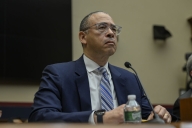You have /5 articles left.
Sign up for a free account or log in.
It used to be that medieval and renaissance maps placed sea monsters and dragons in those seemingly dangerous and unexplored places where seafarers were best to avoid. This is why “here be dragons” is a shorthand expression for stumbling into uncharted territory.
I want to suggest that we may all soon be swimming with those dragons as the second generation of digital learning technologies undergirding MOOCs become ever more commonplace and utilized.
To be clear, I am no techno-cheerleader. I believe that digital learning technologies have clear and defined limits. I am not a machine and I will not be replaced by one, exactly because, if I do my job right, I am able to go beyond the transmission of knowledge to its contextualization and transformation.
But the reality, whether we like to admit it or not, is that much of higher education is fundamentally premised on and built around a transmission model of teaching and learning (i.e., knowledge retention) and a throughput model of institutional success (i.e., student retention). As such, I believe that the second generation of MOOCs will force three distinct yet related disruptions exactly because the technology driving “MOOCs 2.0” – such as automated assessment, adaptive learning, and data analytics – are almost perfectly aligned to such models of education.
(Two asides: The first is that, yes, I know, I know, all eyes roll by now when MOOCs and “disruption” are mentioned in the same sentence; but that doesn’t change the inconvenient reality that MOOCs are but the face of massive underlying technological innovations currently underway. The second is that, yes, I know, I know, higher education is supposed to be about much more than the depositing of knowledge and conferring of a credential; but that doesn’t change the inconvenient reality that the vast majority of our students and institutions don’t experience or accomplish such lofty goals. I thus move forward with my spirit still hopeful as my eyes are wide open.)
The first disruption – at the level of teaching and learning – is already occurring as digital learning technologies begin to produce student outcomes “good enough” and comparable to traditional transmission models of education. This very idea – that anyone, anywhere, anytime could receive a top-notch education from the star professors of the world’s best universities – was what drove the breathless and utopian embrace of MOOCs just two short years ago.
Yet this all came tumbling down as we realized that the first generation of MOOCs were premised on really poor pedagogical principles without any understanding of the last one hundred years of educational research. But even as skeptics pointed to the “hype cycle” and a “trough of disillusionment,” MOOC designers kept building better systems. For there are in fact plenty of foundational pedagogical concepts – mastery learning, real-time formative feedback, chunking of curriculum, adaptive and scaffolded instructional content – that can be engineered directly into online delivery platforms. As this occurs, and the research backs up the MOOC model, our notions of what constitutes good enough teaching will begin to crumble.
The second disruption – at the institutional level – is coming as well as data analytics and the unbundling of traditional administrative and faculty functions supplements and streamlines how we process students through our fragmented postsecondary system. From automated advising systems that recommend courses to the modularization of the curriculum, the fundamental underpinnings of place-based and faculty-driven education are slowly eroding.
I can piece my course credits together by demonstrating competence, through online modules and courses, and with in-seat classes; and I can batch them all together through an e-portfolio, badge system, or pre-approved block transfer agreement. As these back-end technological components became commonplace, only a small percentage of our twenty million postsecondary students will ever have a so-called “traditional” college experience.
The third disruption – at the systems level – is where the dragons swim.
The first two disruptions are certainly meaningful and real in that they will cause dramatic changes in faculty work and institutional practices. We can already see, as a positive example, that the first disruption is fostering active learning through the embrace of the “flipped classroom” model of instruction; or, as a negative example, the loss of faculty autonomy (and jobs) – in curriculum construction, delivery, and advising – as digital technologies go to scale.
But the third disruption will be profound and is truly uncharted. That is because it forces us to reconsider our fundamental assumptions of what it means to educate and be educated. On the one end of the spectrum lies a dystopian vision of deeply atomistic and utilitarian models where the economic imperative trumps the educational vision; on the other end lies an open-ended learning nirvana.
I of course embrace the latter vision to a much greater extent and can see such transformative possibilities at the margins of current practices: things as the DIY movement in higher education, the maker movement, or the notion of the “flipped university.” What all of these ideas have in common is, to return to the beginning, a radical rejection of both the transmission model of teaching and learning and of the throughput model of institutional success. Yet I am all too aware of the fragility of educational reform (just do a little digging about the “Eight Year Study” from the 1930s and 40s).
Nevertheless, I believe we are at a new moment exactly because forthcoming digital learning technologies will create educational models that mirror and improve current educational practices at a scale and pace impossible before now. So grab your life vast, power up your Google Maps app, and beware of the dragons ahead.
Dan Butin, PhD, is an Associate Professor and founding Dean of the School of Education at Merrimack College and the executive director of the Center for Engaged Democracy. He is a non-resident Visiting Scientist at MIT's Office of Digital Learning for the 2013-14 academic year.







